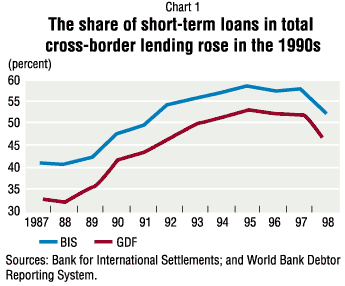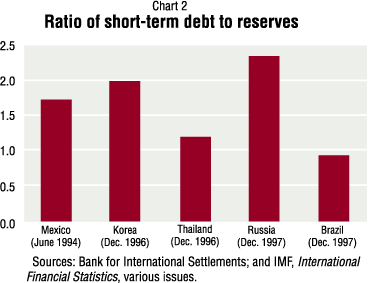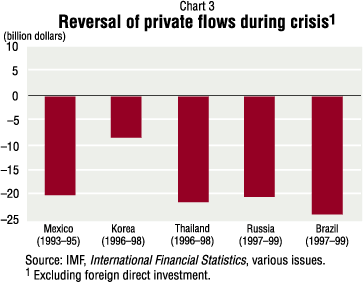 About F&D Subscribe Back Issues Write Us Copyright Information |
The Role of Short-Term Debt in Recent Crises Uri Dadush, Dipak Dasgupta, and Dilip Ratha Short-term debt owed by developing countries to foreign banks rose from $176 billion to $454 billion between 1990 and 1997. This rapid buildup of short-term debt was a key factor in the financial crises that rocked Mexico in 1994-95, East Asia in 1997-98, and Russia and Brazil in 1998-99. The 1990s witnessed a boom in short-term lending by international banks to developing countries that lasted until Asia's financial crisis erupted in 1997 (Table 1). By 1997, nearly 60 percent of all outstanding international bank claims on developing countries had a remaining maturity of less than one year, and some 50 percent of all new loans from international banks had maturities of one year or less, a much greater proportion than at the beginning of the decade (Chart 1). The volume of short-term debt grew fastest in East Asia, followed by Latin America. The top 10 recipients of short-term loans during 1990-96 included Brazil, Korea, Mexico, Russia, and Thailand. Short-term debt exceeded international reserves in each of these countries in the period before the onset of large reversals of private capital flows and the financial crises (Charts 2 and 3).



Another noteworthy financial trend in the 1990s was a substantial increase in the share of private sector borrowing—especially by banks—in total borrowing. An examination of syndicated loan transactions reveals that, in recent years, more than 42 percent of short-term syndicated loans to emerging markets has gone to financial institutions. Almost one-third of short-term syndicated debt has been contracted by commercial banks. Compared with a decade earlier, the shares of short-term debt contracted by oil and gas enterprises and government agencies decreased significantly, while that of financial institutions increased. Short-term lending by international banks increased rapidly despite a decline in the share of bank lending in total private debt flows to developing countries and the flat or declining indebtedness of developing countries relative to their export earnings and GDP. The growth of the developing countries' short-term debt in the 1990s thus reflected the fact that international banks were making more short-term loans even as they were reducing their overall lending to developing countries and their exposure in terms of their capital at risk. Shortening maturities The growth of short-term debt in the 1990s seems to have accompanied higher incomes, stronger GDP growth, and greater openness to trade in borrowing countries. But these factors were only partly responsible for the surge in short-term borrowing. During this period, for example, Asian banks and financial institutions were borrowing heavily—and rapidly building up considerable short-term debt—while fueling a speculative asset boom in Asia and elsewhere. Domestic policy changes, especially accelerated financial deregulation, capital account liberalization without stronger prudential regulations, and, in some cases—for example, that of Thailand's BIBF (Bangkok International Borrowing Facility)—tax incentives to attract short-term flows contributed to the shortening of maturities and to what we can now see, with the advantage of hindsight, was excessive borrowing by banks and financial institutions. Short-term borrowing from abroad was also encouraged by government attempts to support pegged exchange rates by sterilizing capital inflows, thereby keeping domestic borrowing costs high. In addition, short-term lending was driven by external, or "push," factors. Interest rates—especially short-term rates—dropped in the industrial countries in the 1990s, causing an expansion in global liquidity; some of this encouraged short-term lending to developing countries. Rescues of banks during banking crises (for example, in Sweden and Mexico, where short-term loans were rescued first) may have created moral hazard, encouraging international banks to extend short-term loans, especially to banks in developing countries. Debt maturities may also have been influenced by Bank for International Settlements (BIS) regulations on minimum capital-adequacy ratios for international banks lending to countries that were not members of the Organization for Economic Cooperation and Development (OECD)—only 20 percent for short-term lending, compared with 100 percent for loans with maturities longer than one year (Table 2). Economic shocks One potential advantage of global financial integration may be the enlarged access it gives countries to international capital markets, which allows them to borrow to smooth consumption in the face of adverse economic shocks. But the advantage of contracting short-term debt for countercyclical purposes can be wiped out if lenders' decisions, changes in risk perceptions, and other factors make access to such short-term capital flows procyclical. Favorable shocks may attract large capital inflows and encourage consumption and investment at levels that are unsustainable in the longer term, and countries may be forced to overadjust to adverse shocks when capital flees.
Short-term capital flows appear to be procyclical in developing countries, increasing when economic growth is cyclically faster and declining when growth rates falter. Based on data for 33 developing countries during 1986-98, the elasticity of short-term debt with respect to GDP is about 0.9 when GDP growth experiences a positive shock (defined as a rate of growth that is one-half standard deviation or more above the mean growth), but it is 1.8 when an adverse shock occurs (that is, when GDP growth is one-half standard deviation or more below the mean). In other words, the rate of decline of short-term debt during an adverse shock is twice as high as its rate of increase during a positive shock. In contrast, the analysis suggests that medium- and long-term debt may be weakly countercyclical to GDP shocks.
Such procyclicality by itself, however, is not necessarily a cause for concern, because it may respond to changes in demand in the developing countries themselves. However, when this procyclicality arises from external, supply-side factors, such as sudden changes in terms of trade, it can substantially accentuate the impact of a shock. The procyclical response is (again) found to be twice as large when a developing country faces an adverse terms-of-trade shock as when it faces a positive shock. Finally, there is evidence of a nonlinear relationship between the risk perceptions of creditors and economic shocks in developing countries. This relationship lies at the heart of the greater procyclical response of short-term debt to adverse shocks. Perceived risk may increase more during a large adverse shock than it declines during a small adverse or a positive shock.
Two reasons may explain the procyclical behavior of short-term capital flows. First, economic shocks tend to be larger and more frequent in developing countries, reflecting these countries' narrower economic bases and greater dependence on primary commodity exports. Adverse shocks cause a country's creditworthiness to be downgraded. Changes in risk perception and rating downgrades can lead to rationing of credit to marginally creditworthy borrowers, and such changes can worsen rather than smooth their adjustment. Second, these negative effects are exacerbated by the asymmetry of information available to borrowers and lenders, which may trigger herd behavior as panicked investors rush to withdraw their capital in response to an adverse shock. Vulnerability to crises Of the different types of private capital flows, short-term loans are the most likely to be withdrawn during difficult times. The cost of pulling out is minimal for lenders of short-term debt, whereas liquidating foreign direct investment may involve selling plant and machinery, and selling stocks or bonds during a crisis usually involves a loss for the sellers. Many countries suffered large reversals in short-term capital flows during the recent financial crises, precipitating severe external liquidity crises. Developing countries that had enjoyed short-term debt inflows from BIS-reporting banks of $43.5 billion in 1997 suffered outflows of $85 billion in 1998 (Table 3). Quarterly data suggest an even more dramatic swing. The association between excessive growth in short-term banking debt and subsequent financial crises is not a new phenomenon; it was also observed in the late 1970s. In both the 1970s and the 1990s, the crises were preceded by a rapid shortening of maturities of international bank loans to developing countries (Chart 4).
The reversibility of short-term debt predisposes borrowers to "liquidity runs." The higher the level of short-term debt relative to a borrowing country's international reserves, the greater the risk of such runs, although they increase the likelihood that lenders' worst fears will be realized—the chance of being repaid declines rapidly once a run has started. High levels of short-term liabilities involving the financial system also involve risks of bank runs and systemic crisis. Therefore, the risk of financial crisis is greater when the ratio of short-term debt to reserves is excessive and the banking system is heavily involved in intermediating debt flows. Since residents may opt to liquidate their short-term assets in the banking system and move them abroad in the event that risks rise, the ratio of broad money to reserves is an additional indicator of vulnerability. Conclusion The growth of short-term borrowing in the 1990s naturally accompanied higher incomes, faster growth, and greater openness to trade in developing countries. But the rapid rise in such borrowing also reflected speculative asset booms in some countries. Furthermore, policy changes such as financial deregulation and capital account liberalization in developing countries, combined with distortions in international capital-adequacy regulations, favored short-term lending. These, in turn, increased the vulnerability of many countries, as in East Asia, to liquidity crises, especially as short-term borrowing tended to reverse rapidly during adverse economic shocks. Given the risks excessive amounts of short-term debt pose for developing countries, it is essential that they monitor such debt (particularly debt intermediated by domestic banks) closely and manage it effectively to avoid currency and liquidity crises. Domestic policies that encourage short-term borrowing—either directly through tax incentives or low reserve requirements, or indirectly through pegged exchange rates and sterilization of inflows—should be avoided. Chilean-style reserve requirements, according to which a given share of all inflows is deposited with the central bank for up to one year, can lengthen the maturity of inflows but can also raise borrowing costs. Excessive short-term borrowing for financing long-term investments (such as lending to the property sector) should be discouraged. In short, developing countries need to strengthen prudential controls on cross-border borrowing. Unfortunately, this is not an easy task, because existing reporting systems fail to capture a significant part of potentially reversible short-term components of capital flows. Significant omissions include investments in developing country assets by international mutual funds and non-BIS banks, nonresident deposits, and interfirm cross-border flows. The Inter-Agency Task Force on Finance Statistics, with participation by the BIS, the IMF, the OECD, and the World Bank, has recently been established to improve the quality, frequency, and coverage of debt information.
This article is based on a longer analysis published in World Bank, Global Development Finance 2000 (Washington).
|
|||||||||||||||||||||||||||||||||||||||||||||||||||||||||||||||||||